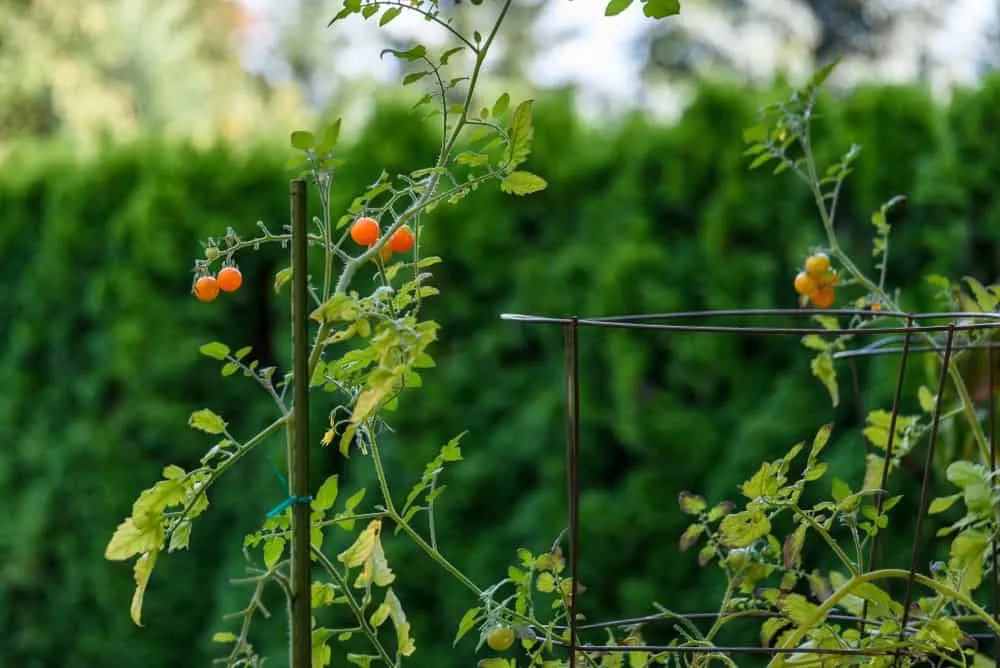
Like humans, tomato plants need a little support to give their best. Physical support that is, not emotional support (although that couldn’t hurt).
There are several ways to support your tomato plants as they grow.
Two of the most popular methods are staking and caging. Both methods have passionate defenders who swear by their methods, but which one is really better?
What is Staking and Caging?
Before deciding which method is better, let’s start with what these methods are and what they entail.
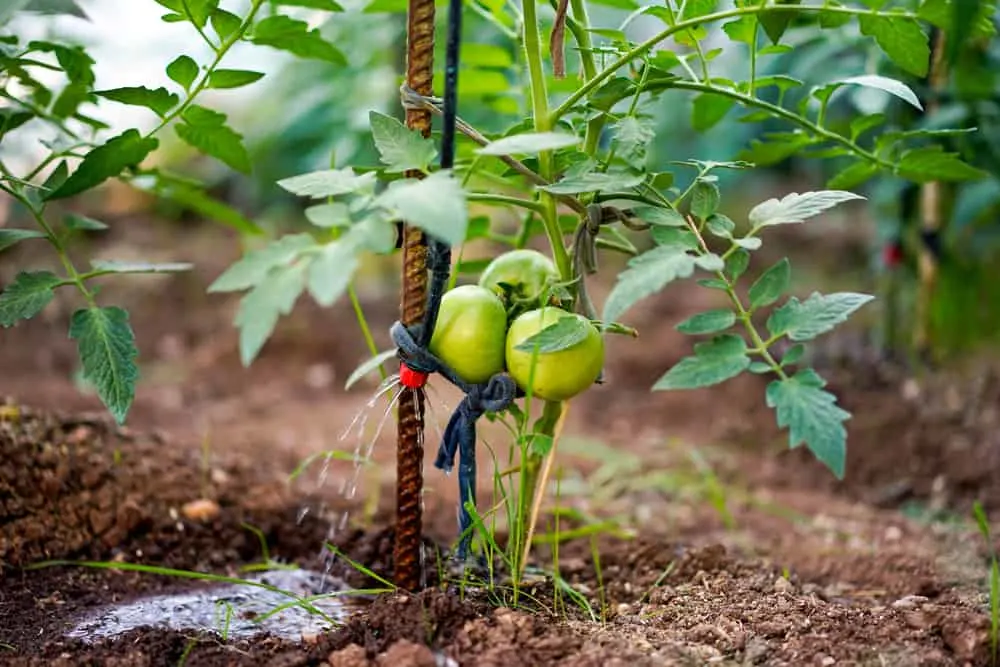
The names are relatively self-explanatory. Staking involves tying the stems of the tomato to a stake next to the middle of the plant. Stakes are typically made from wood, bamboo, plastic, or metal.
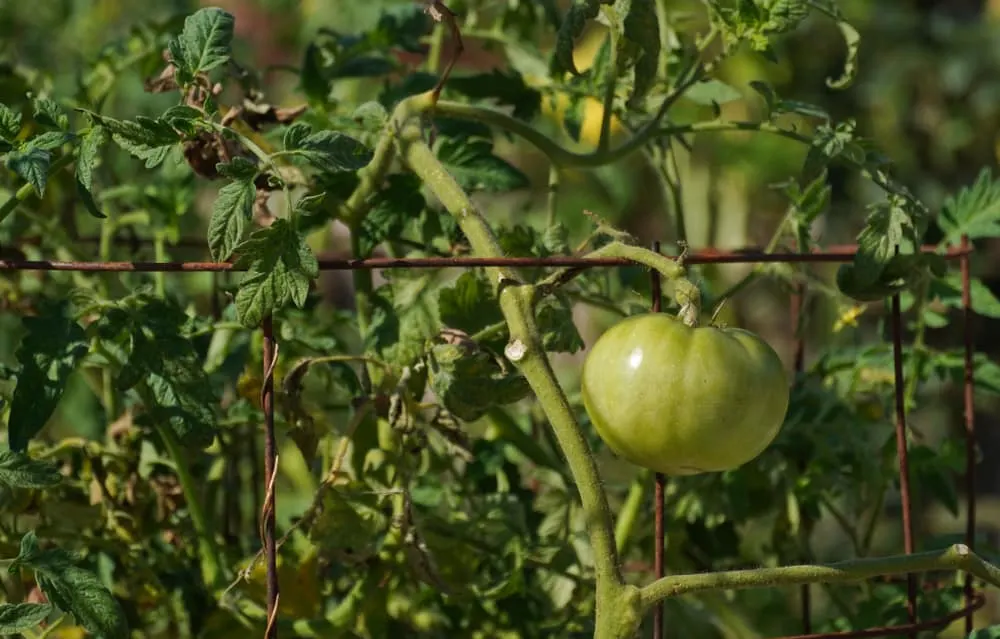
Tomato cages surround the entire plant and the sides support the stems as they grow. Cages are typically made from heavy-duty metal or wood to support the weight of the entire fruiting plant without falling over. The cage needs to be tall enough to support the plant throughout growth. The size will vary depending on your chosen variety.
5 Reasons To Support Your Tomatoes
There are a couple of time-consuming gardening tasks we’d rather not have to do – supporting tomatoes is one of them. It may take time and some hard work, but it is an important practice for the health of your tomatoes.
Supporting your plants provides a range of benefits:
1. Preventing Pests
Lifting your plants off the ground keeps the leaves and fruits away from the soil and ground-dwelling pests. It won’t prevent pests altogether, but it will make the plants less accessible to some.
2. Limiting Diseases
Tomato plants left to sprawl along the ground are in contact with the soil, increasing the chances of soil-borne diseases. After watering, the plant will also be sitting in water on top of the soil, increasing the probability of rot or mildew.
3. Simplifying Plant Care
When tomato plants are supported, they are much easier to access, making tasks like pruning, harvesting, or removing pests simpler.
4. Reducing Competition
Properly supported tomato plants have more space to grow. If two or more plants are left to grow along the ground, they may spread out and mix with each other, competing for light and water.
5. Preventing Damage
The most important reason to support your tomatoes is that some plants can’t support themselves. Tomato varieties can grow several feet tall and may fall over or snap under the weight of the tomato fruits.
While most tomato plants benefit from some kind of support, there are a few varieties that can stand up on their own.
Indeterminate vs Determinate Tomato Plants
Tomatoes can be divided into determinate and indeterminate varieties. Determinate tomatoes grow to a set height and the fruits ripen at the same time, while indeterminate varieties continue to grow throughout the season, potentially reaching over 10 feet tall.
Some determinate varieties don’t grow very tall and can usually support themselves – typically the ‘patio’ or ‘dwarf’ varieties. However, most tomato varieties, whether determinate or indeterminate, will need and benefit from support.
So, which support method should you choose?
Staking or Caging: Which Method is Better?
Although it may be unsatisfying, the answer is not straightforward. Staking and caging are each better in different situations. It all depends on the varieties of tomatoes you choose, the space you have, your budget, and a host of other factors.
Take a look at the pros and cons of each method to decide which best suits your situation:
Pros of Staking
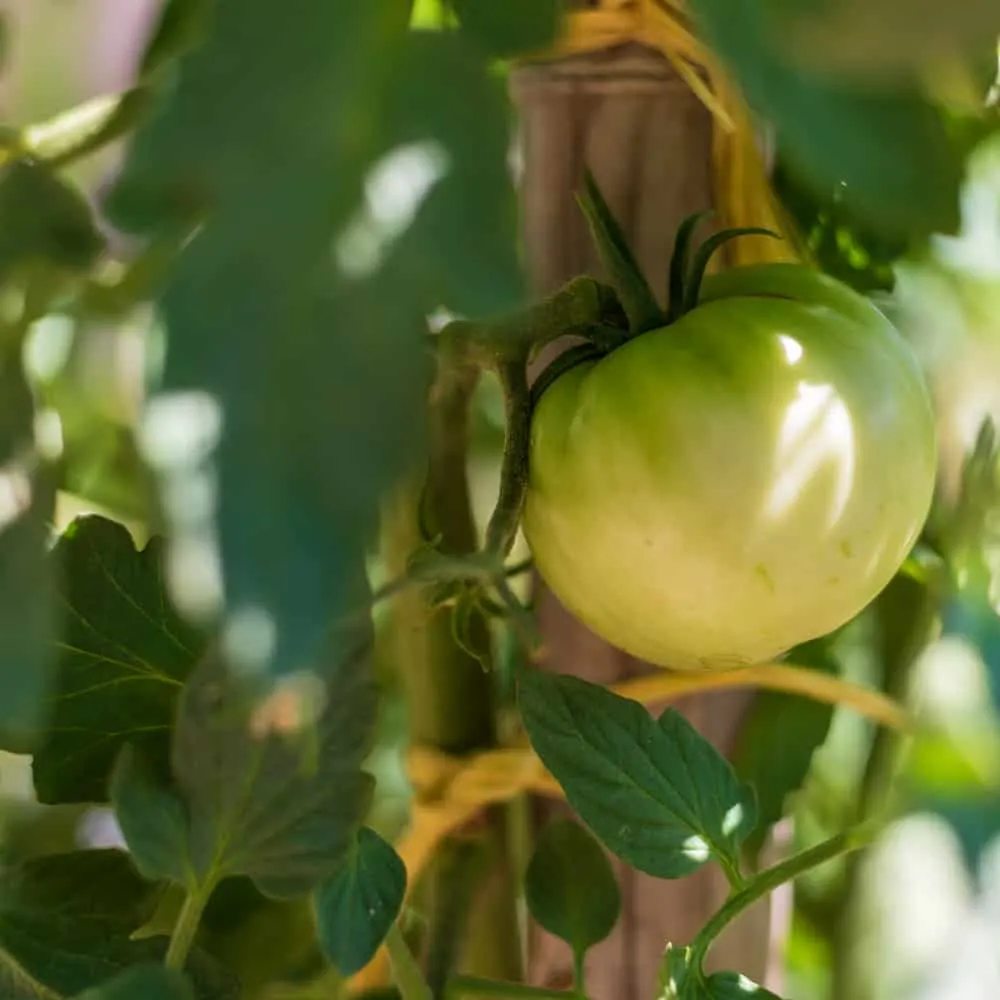
- Simplicity: Staking is one of the easiest and quickest support methods to implement. Place the stake next to the plant and tie the stem to it as it grows.
- Space: Staked tomato plants grow upright with less outward branching, saving space and leaving room for more tomato plants.
- Pruning: Staked tomato plants are easier to prune. Pruning allows the plant to direct more energy toward producing fruit, resulting in an earlier harvest and larger tomatoes.
- Light and Air: As the leaves don’t branch out as much, tomato plants that are staked typically get more light. There is also more air circulation around the plant, lessening problems with pests and diseases.
- Ease of Access: Harvesting from staked tomato plants is far simpler than from caged ones.
Cons of Staking
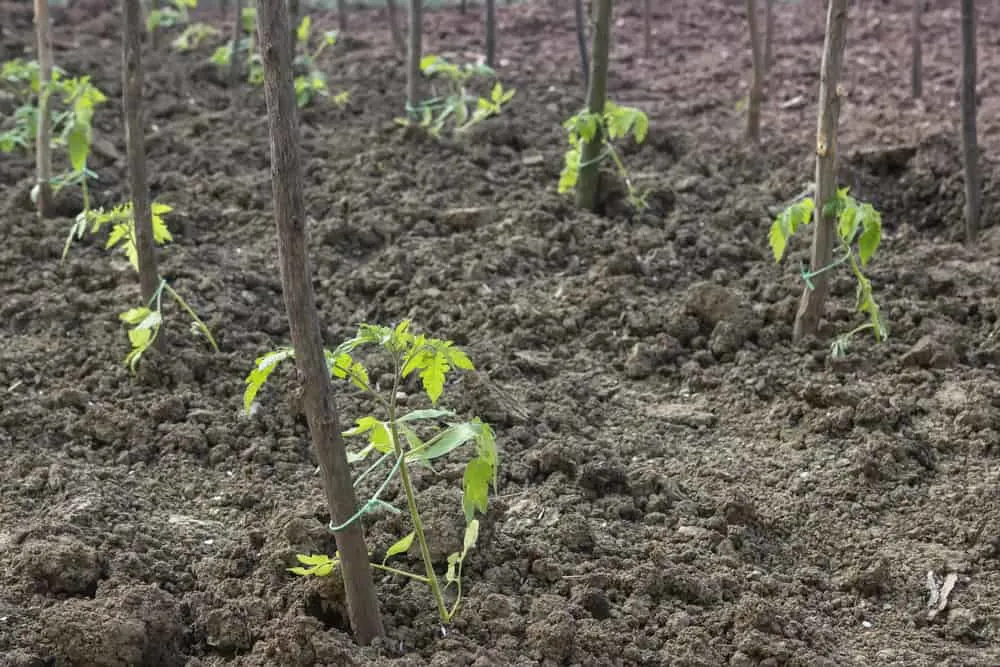
- Damage: Heavier plants are difficult to tie to stakes – too loose and the plant will fall over, too tight and the stem will sustain damage.
- Time: Although it is quickest to implement initially, training and tying the stems as the plant grows takes more time overall.
- Sunscald: Less leaf cover exposes all parts of the plant to the sun, which can lead to problems with sunscald.
- Water: Greater sunlight and air circulation dry out the soil faster, so the plants will need to be watered more often.
- Pruning: A pro and a con – while pruning is good for the plant, it can lower overall yield and become time-consuming. When tomato plants are staked, they have to be pruned often to keep the plant tidy and off the ground.
Pros of Caging
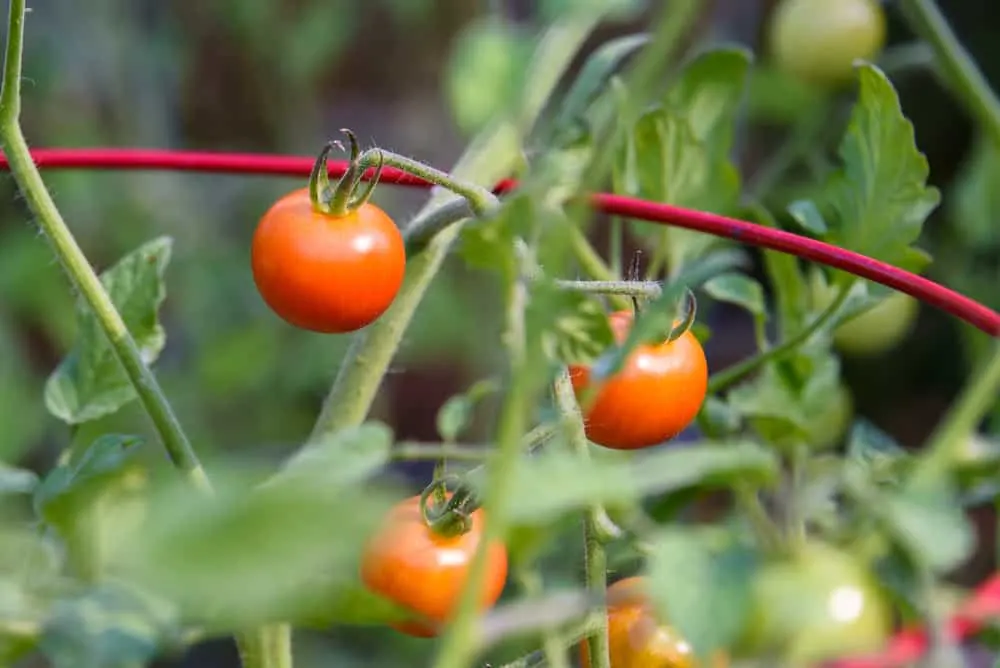
- Timesaving: Caged tomato plants require less maintenance. Once the cage is in place, it will continue to support the stems and the plant will require little to no pruning to keep lateral branches off the ground.
- Leaf cover: The density of the leaves protects the fruits from sunscald and shades the soil from sunlight, helping retain moisture.
- Reusability: Stakes are often made from wood or bamboo which degrades faster than the metal wire used to make tomato cages. They can be reused season after season before they need replacing.
Cons of Caging
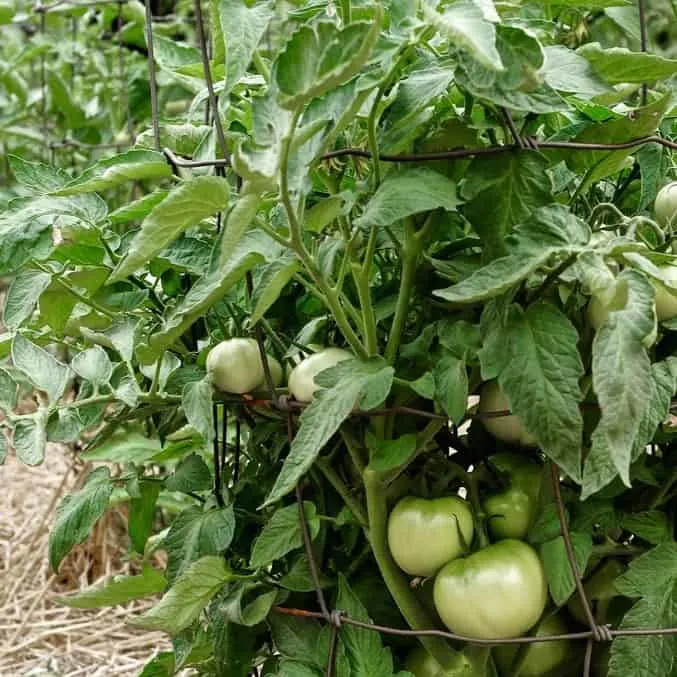
- Size: Tomato plants can outgrow their cages, either becoming too tall or too heavy for the cage to support the plant. If the plant outgrows the cage it may fall over, potentially toppling and uprooting the plant.
- Space: Wide cages take up far more space than tomato stakes.
- Harvesting: It can be difficult to tell when the fruits are ready for harvesting. It is also harder to access the center of the cage to retrieve ripened tomatoes.
- Pests: Parts of the tomato plant aren’t easily accessible. This makes it difficult to remove any pests by hand or to apply pest control products to the affected areas.
- Cost: Heavy-duty tomato cages tend to be more costly than stakes, but they do last several years and can be considered a one-time investment.
Your choice between staking and caging will depend on your circumstances. Don’t enjoy pruning? Go for caging. Don’t have a lot of space? Choose staking. No matter which you choose, your plants will have far greater chances of success than if they were left to grow without support.
How to Stake Tomatoes
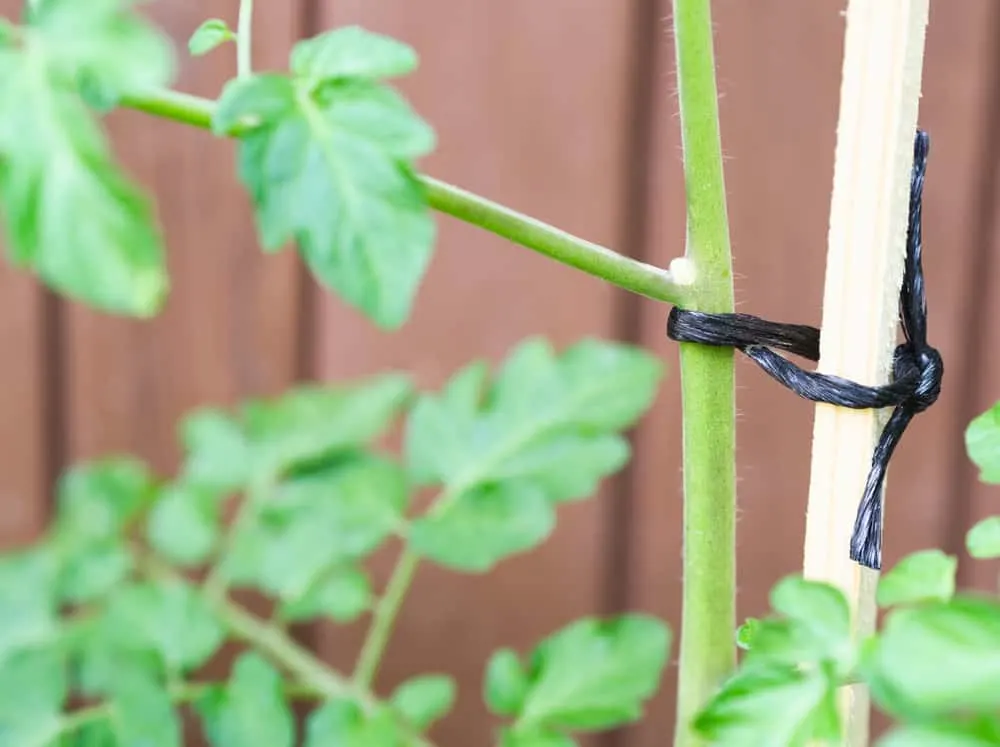
If you’ve decided to stake your tomatoes, start with a stake matched to the potential height of your plant (plus a bit of extra space for the section dug into the ground). Use a stake with a rough texture to ensure the ties don’t slip off.
Push the stake into the ground immediately after planting to avoid disturbing the roots later. Leave about a foot in the ground for stability and keep the stake a few inches from the base of the plant.
As the stem grows, tie it to the stake using gardening wire (coated wire to protect the stem from damage). Cloth and string work well too. Ensure the ties aren’t too tight as they can cut into the stem and damage it. Prune any unwanted lateral branches and continue to tie the plant to the stake until it is fully grown.
How to Cage Tomatoes
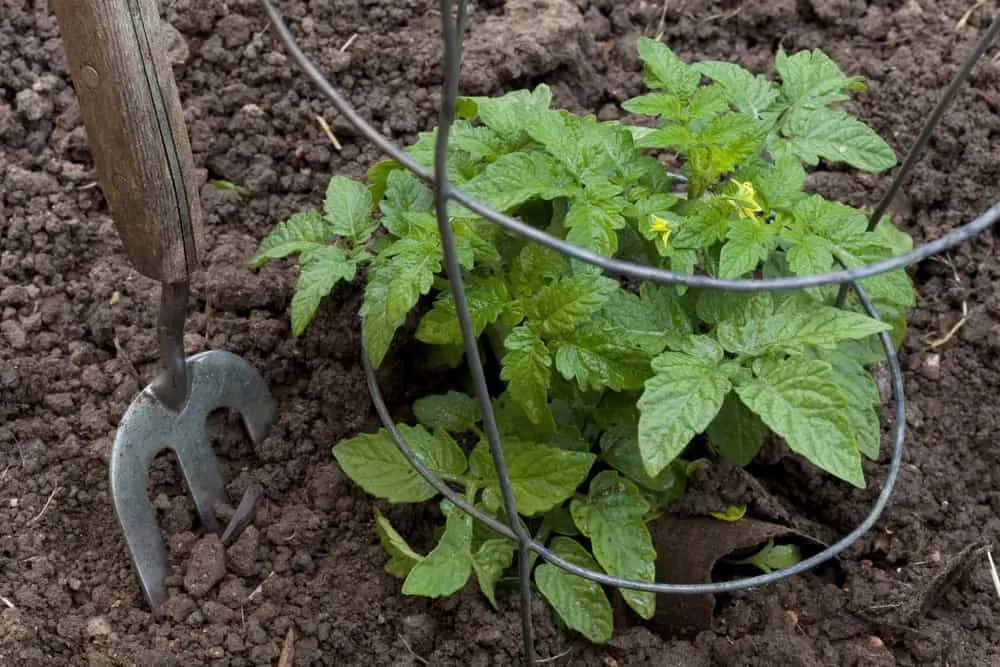
Installing a tomato cage is a similar process to installing a stake. Choose a cage the right size, leaving enough space for the fully grown plant to reach the top. The holes should be large enough to fit your hand through and the materials should be sturdy enough to hold the plant upright. If no heavy-duty cages are available, you can make your own using concrete reinforcing wire.
After planting, while the soil is moist, push the cage into the ground around the plant, keeping the seedling at the center of the cage. Compact the soil around the cage to set it in place. It should not move with pressure – it needs to withstand the weight of the fully grown plant.
Pull the stems through the wire as the plant grows. If the plant begins to outgrow the cage, you can add an extension to support the plant further.
Simply place your hands through the gaps of the cage to prune or harvest the tomatoes.
There is no doubt your tomatoes will benefit from some extra support. Whichever method you choose – whether it be the popular staking and caging, or any of the other options – will give you a higher yield and healthier tomato plants overall. That is certainly worth the extra effort.
